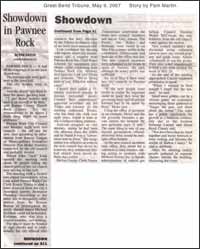
|
|
|
Search our site
Check these out    Do you have an entertaining or useful blog or personal website? If you'd like to see it listed here, send the URL to leon@pawneerock.org. AnnouncementsGive us your Pawnee Rock news, and we'll spread the word. |
Too Long in the WindWarning: The following contains opinions and ideas. Some memories may be accurate. -- Leon Unruh. Send comments to Leon May 2007June in Babylon[May 31] O Larned, Babylon on the Pawnee! To a boy like me, driving over from Pawnee Rock to hold my first job after graduating from high school, Larned was a city of grand possibilities. There was money to be made, and there were ways to spend it. There were restaurants, bars, and girls I hadn't grown up with. Larned of the mid-1970s had about 5,000 people, making it a dozen times larger than our hometown, and it had attributes befitting a metropolis. There was a big library, a city pool, and a park with Pawnee Creek flowing past it -- plus a warren of old houses on the hill where no questions were asked. In Larned, you could do things without the fear that your parents would hear about it before you got home. In Larned, a kid from a neighboring town could get away with anything. That's not always good, but it is when you're 18 years old and curious. Being a reporter at the Tiller and Toiler meant I had access to people: politicians, businessmen and businesswomen, teens at the pool, baseball and softball players, pig farmers, physicians, the police chief, and the police chief's son and daughter. Everywhere I turned, day or night, there were new folks who respected my job and were glad to meet me. It was like going to a buffet, and all I had to do was pick up a plate. As Larned became the focus of my life, a lot of the acquaintances became friends. Often I would work into the night and then meet my friends at The Back Door or, just as often, at their back door. Maybe you've seen the movie "Moulin Rouge!" in which a penniless and naive writer moves to Paris and falls in with a bohemian crowd of artists, dancers, and absinthe drinkers. There are some similarities in our story, but while that writer saw the absinthe-inspired Green Fairy, I saw Purple Jesus. Purple Jesus is a drink that, on the night I'm writing about, was mixed in the stoppered kitchen sink of a two-story house on Sixth Street. The ingredients were within the budget of anybody with a job or an allowance -- 190-proof grain alcohol, leavened with vodka and masked with grape juice. In my brush with blasphemy, I became enlightened: This party was not like the sullen parties in Pawnee Rock or Macksville, where the goal was to get drunk on a back road. Here, it was to be imaginative while drunk. Kids, there are many ways to have illicit fun. You can sing loudly, you can climb out onto a roof with a girl, and you can end up walking the runway of the county seat's airport at 2 in the morning. At least, those are some of the things Purple Jesus would have you do. You wouldn't try those things now, kids, because of DWI laws and because you're so much smarter than we were. But you should know how things used to be back when it was June in Babylon and your parents were young. Looking for Helena Unruh: One of our readers, Eva Kay Couch, is looking for information about Helena Unruh, who lived in the Pawnee Rock area many years ago. I don't have the information at hand, but perhaps someone knows. Here's what Eva Kay wrote: My Grandmother was Eva Unruh Wedel. She was born at Pawnee Rock in 1885. We think her mother died at child birth or shortly afterward, because when she was 3 her father, Benjamin C Unruh remarried at Durham, KS. My mother and her sisters are looking for her grave. We were wondering if you have any cemetery records for the Mennonite Cemetry. Her name was Helena Unruh. Maiden name was Becker and they were born in Russia and came to America in November 1874 then came to Kansas. If you know anything we would love to hear from you. Thank you for your time, The school reunion[May 30] Leon Miller (Class of 1951) met some familiar folks this past weekend at the Pawnee Rock school reunion. Here are excerpts from notes he sent: "My wife and I drove up from Dallas and attended the services at Pawnee Rock Cemetery, as well as the dinner at the old school afterwards. I was privileged to meet old classmates (John Woelk and Richard Spreier -- class of '51) as well as others from prior years. The oldest graduate there was a lady in the 1933 class. I don't remember her name. . . . "Some people in the community had put together a nice lunch and the usual 'meeting' or 'class roll call' was held afterward. I sat next to a fellow named Glenn Mull, the son of Keith Mull, one of my Dad's good customers, whom you may know, and a young lady whose mother was Nancy Converse and grandmother was the Converse who would have been the postmaster about my time. They told me a funny story about my Dad [Cobb Miller, the Mobil man] that I never knew, and that was he always carried bubble gum and candy in his gasoline truck and gave it out to the children whenever he made a delivery. That must have happened after I left the community as he never mentioned it to me. "I did visit with Earl and Janice Schmidt, as well as Janice's sister, Joan. "Lastly, as I was strolling around the cemetery I ran across a name on a stone that I believe was part of the 1915 Pawnee Rock basketball team that I had given out the names of earlier. The person's name was Leonard Kell, whom I recall my father said went by the name of 'Link' Kell. I say this because he was born the same year as my father, 1897. So that may close the mystery of the missing basketball player." Leon also mentioned that there was discussion about the sale of the school to some folks from California who are in some computer business. Details about the deal were in short supply, although many people were curious. OK, class: Does anyone have the name of the oldest graduate at the reunion? Does the name "Link Kell" ring a bell as a member of the basketball team? Hugh Preston Barrett: The Rev. Hugh Preston Barrett, who graduated from Pawnee Rock High School around 1940 and went into the ministry for the Christian Church (Disciples of Christ), has died in Wichita. He was born near Larned and married Audrey Lucille Wilson in 1946. She survives. He'll be buried at 4 p.m. Saturday in the Pawnee Rock Cemetery. (Obituary) What the soldiers know[May 29] The flag, hanging quietly at half-staff, was lowered as the military band played "The Star-Spangled Banner," and then it was raised smartly. At the top, the wind filled the banner, and the Memorial Day ceremony was begun. 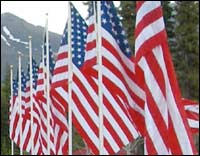 About three hundred people -- a few teenagers, toddlers in strollers, young parents, uniformed men and women who had been through the grinder once or twice already, and a lot of folks with a slow step -- were gathered in the national cemetery on Fort Richardson, the Army post near where we live now. The clouds were low, although the sprinkles were still an hour away, and the crowd was somber. Beyond the spruces to our left were the freshest graves. Among those of old veterans and their spouses were new markers, lined up where the grass hadn't grown back yet. Their bodies had been flown back from Iraq and Afghanistan to lie where their families were living. Fort Richardson, the post outside Anchorage, has lost about 80 men in the present wars. Most of the dead are buried elsewhere -- Texas, Georgia, California, Virginia -- but the few who came back to us are our physical symbol of what our country has spent in a distant land. They are buried next to 5,400 men and women whose white marble markers bear the legends "World War II," "Korea," and "Vietnam." I had taken our son Nik to the ceremony, his first trip to this cemetery. We stood in the chilly wind and said the Pledge of Allegiance; nodded through the invocation; clapped for the state's senior senator, the governor, and assorted officials; and listened to a good speech by Orin Hatton, a well-tended man from the National Cemetery Administration. A man from the VA hospital system read the presidential proclamation, and the governor spoke for a few minutes about how she had brought her daughters to the ceremony so they might better understand the day's meaning. She turned to the assembled mothers and with a choked voice thanked them for their sacrifice. The most eloquent person of the day was not a politician or a bureaucrat, but a thin fellow who stood twenty feet to the right of Nik and me. He must have been in his early thirties, and his face was rock hard. The polar bear emblem of the U.S. Army Alaska glared from the left shoulder of his dress uniform. He didn't say a word. He looked like a killer, and halfway around the world he probably was. At the end of the ceremony, when the crowd shifted, I saw that he had a possessive and gentle hand on a folding chair in front of him. There sat a boy, with the same tender face as Nik. The boy, maybe his son, turned and smiled up at the soldier. Whether we're in Pawnee Rock or some city far from home, the ceremony on Memorial Day is universal, as much of a national ceremony as it's possible to have. And still, soldiers and families of soldiers feel the day differently from those who aren't; we who stand politely among the veterans simply do not know what they know. Memorial Day isn't just for the dead, although it's fitting and proper that we honor both the immediate victims of war and those who served a lifetime ago. The day is for the living, too, a day when we promise the soldiers and airmen and marines that their service and risk will be remembered brightly by families who lend them to the country and by the rest of us who are their neighbors and friends. It's for men and women like the ramrod soldier from Alaska, who fight the good wars and the bad ones because of duty and honor and a nine-year-old son. The Rock of ageless memories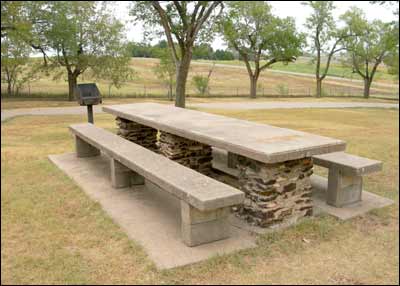
Pawnee Rock school classes and entire families have had picnics at this table for many decades. The table may have been built by 1920, when the pavilion was erected. [May 28] Sharon Quincy wrote that she and her family might have a picnic today on the Rock after the Memorial Day ceremony at the cemetery. Indeed, what could be more "Pawnee Rock" than a May picnic on the timeless slopes? What is better than climbing the steel steps to the concrete observation deck of the pavilion and facing into the timeless wind and walking around the four sides to see the expanse of Barton, Pawnee, Rush, and Stafford counties? I once scratched my initials into the Rock, although I haven't been able to find them for years. But just as the letters are there somewhere, the Rock has made its mark on me. The Rock is a great holder of memories; we all had special moments there. There are times I'm reluctant to go to the Rock because I know I'll end up reminiscing the whole time instead of scampering over the red sandstone and looking for the oldest scratched date or examining the plants, as I intend to do. I, and maybe you, have sledded between the trees on the north side. I strained to ride my bike around the loop. I got my first real kiss while parked next to the pavilion. I shot fireworks on the Rock, and so did my young sons. I mowed the Rock three times one summer, and I saw an enormous tornado from the summit in 1974. Several of my school classes had picnics there. Sitting near the cannon mounts, I imagined the Santa Fe trail and Kiowas and Pawnees, and right next to the little concrete bridge is where I first knifed open a yucca pod. We from Pawnee Rock all own this special landmark, as old as history itself. It means something different to each of us, yet it's the touchstone we share. It lifted us above our hometown so we could face the sun and the stars and the wind and dream. Whether or not we still live in Pawnee Rock, the Rock is in our hearts. 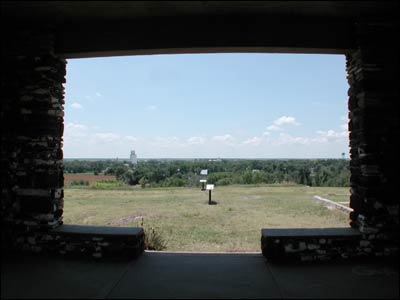
Looking south toward Pawnee Rock from the pavilion. The Herald and our early history
[May 27] The Pawnee Rock Herald kept the record of Pawnee Rock from July 14, 1904, through June 3, 1937. As you'd expect, its pages contain births and deaths, baseball games and railroad schedules, and little mentions of such things as a new shipment of peaches in at the store. The paper's significance, however, goes beyond that.
The wagon ruts mentioned in the article have generally been plowed under and are visible now only where they cross Ash Creek, and Highway 50N is now called Highway 56. For the moment, though, let yourself imagine a time before the railroad came, when there was nothing but grassland around a much taller Pawnee Rock. History of Pawnee RockPawnee Rock, a little city of 400 people, is located 14 miles west of Great Bend and 9 miles east of Larned and is situated on the southwest edge of Barton County. Pawnee Rock was laid out and incorporated over fifty years ago. One of the founders was ex-Governor Edward W. Hoch. The town received its name from one of the most historic spots in Kansas, Pawnee Rock, which is located a mile north of the townsite. This huge rock stands out on the prairie like a beacon and was used as a guide for travelers to the Great Southwest, and gold seekers who traveled this way in 1849, on their way to California. Long before this, however, Pawnee Rock's importance was realized and used by the Indians. in the vicinity of this huge rock were fertile grazing pastures for the buffalo herds that roamed the prairies, and many bloody battles were staged among the Indians over the possession of these feeding grounds, the Pawnees being the principal aggressors in these encounters. Thus Pawnee Rock received its name. No important battles were staged between the Indians and the whites in this vicinity but many skirmishes which sent wagon trains to the shelter of Pawnee Rock where they made a stand and drove off the marauders, were staged. Weary travelers used the Rock as a guide as well as a camping ground and shelter against hostile Indians and at night as many as 200 wagon trains could be seen camped around its base as mutual protection against the marauding Indians. 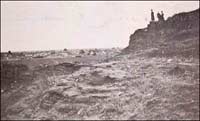 Today from the top of Pawnee Rock may be seen the evidence of the passing of these hardy pioneers, as the tracks left by their wagons still stretch to the Southwest, and carved in the Rock are many inscriptions, the earliest is 1825, giving mute evidence of the passing of these brave empire builders. The Rock figured so importantly in Kansas history that in 1912 it was taken over by the state and designed as a state park, and with civic organizations, appropriate structures were erected to commemorate the building of the Great Southwest. The site was donated by the late Benj. P. Unruh, one of the pioneer settlers. Before the Rock's historic important was realized many tons of stone had been removed from its summit, and used for building material. Many of the stone buildings in Pawnee Rock, including The Herald office, contain this material. Many tourists pass through Kansas on Highway 50N, the old Santa Fe Trail, and a few hours spent in the Pawnee Rock State park, would be well spent, as the view from the summit of the Rock is unsurpassed in scenic beauty. Fred Schmitt: Fred Schmitt, who was the manager of the Great Bend Co-op when it was merged with the Pawnee Rock Co-op -- Farmers Grain -- has died. He'll be buried Wednesday in Dodge City. (Obituary) A photo I like: No. 38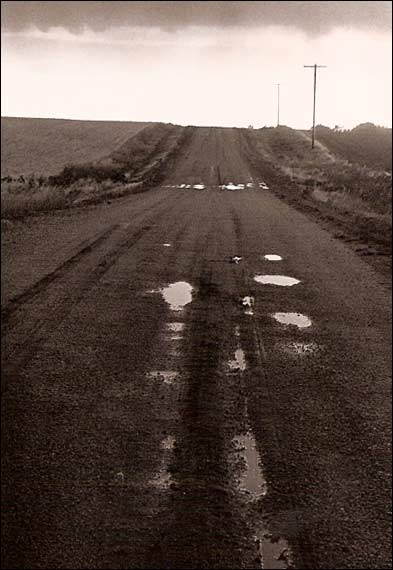 [May 26] The rain had passed, leaving small puddles on the road between the salt plant and the Paul Schmidt farm. I can't remember why I happened to be in the country this time, but I often went out to look for lightning and tornadoes when the clouds gathered with a nice backlight from the evening sun. I made this photo in the 1970s, but the texture and light are timeless. Biking on the big roads[May 25] "Stay off the highway!" Mom emphatically told me whenever I announced my plans to ride my bike from Pawnee Rock to Great Bend or Larned. That was good advice. In the 1970s, U.S. 56 was not a super-two-lane with shoulders. The asphalt ended abruptly just outside the white line, and the lanes were not especially wide to start with. It was before the time of destroyer-size pickups, but even then there were, among the polite drivers, crazy people who crowded cyclists off the road just because they could. There were also cattle trucks, pushing a pillow of air before them and dragging a stinky vortex across the plains. So I rode the back roads to the big cities: the correction line west to Toles Avenue, then south into Larned, and the Mennonite Church road north to the Dundee road with a jog up to 10th Street if I were going to Great Bend. These roads were asphalt and had little traffic, so I could enjoy the view of the Arkansas valley from atop the hills. The biggest annoyance usually was plowing through clouds of gnats that came from the ditches. But one time (well, more than once), I rode on the highway. I know, I know -- there's nothing stupider than an overconfident high school kid in cutoffs on a bike on the highway. But I was in good shape and could go from Larned to PR in 25 minutes, which cut my exposure considerably. Unless one 18-wheeler going my way wanted to pass another one. Which is what happened one day just west of Ash Creek. As I rode, I heard a semi behind me honk his air horn. I waved in appreciation of the warning that it was going to pass. But it kept honking. I turned my head, saw the double-barreled grills coming at me at 60 mph, and turned right down into the buffalo grass. I said some bad words, at the truckers but mostly at myself both for not paying better attention and for being on the highway in the first place. I was shaken up, and I hopped onto the first dirt road that connected me to the correction line for the rest of the ride home. I didn't tell Mom. But don't think I've ever forgotten the lesson. Now comes Biking Across Kansas, that annual mass two-wheel movement from Colorado to Missouri. I'm making the trip in a couple of weeks, and it'll be my third time. This year there's something different: I'm taking Sam and Nik, who are 11 and 9. Living where we do now, the boys don't get highway-riding experience because every highway here is the equivalent of a freeway. We ride in neighborhood traffic, and it's notable that the boys have never felt the exquisite fear that a pushy Ram or Peterbilt instills. Sam and Nik will have one advantage on this trip that I never had when I was learning the way of the road: a hypervigilant dad riding with them. A few months ago we taped up a map of Kansas, with the BAK route highlighted, and have marked off the mileage as we accumulated it on our bikes, which were mounted on training stands. We've also ridden on the paved trail along the highway, and last weekend Nik challenged me to a 100-lap race on the grade school's outdoor hockey rink (the ice is gone, and 100 laps equals 7.5 miles). All this short-distance training is pretty boring, even when we can watch TV while we're riding. It'll be different completely on June 9 when we mount up with 797 other riders in the heat, the wind, and the traffic. Sam and Nik have never stood on the Colorado border and faced east with nothing but 496 miles of highway before them. They have no idea what to expect, but they're in for a treat. They're going to see Kansas. Memorial Day weekend: If you're going out of town, I want to see you back here next week. Drive defensively, please. Don't make news. Memorial Day plans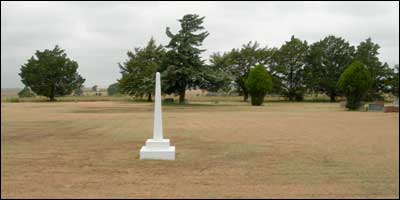
Pawnee Rock's Memorial Day services are held at this monument in the center of the cemetery. This photo was made in August 2006. [May 24] The Pawnee Rock community will commemorate Memorial Day at 11 a.m. Monday at the Pawnee Rock cemetery north of town. This is the time of year when the cemetery is at its prettiest, with gifts of flowers at the markers and little American flags standing above every veteran's grave in a field of green grass. (Previous writing about the cemetery or Memorial Day: here, and here, and here, and here, and, finally, here.)
Immediately after the ceremony, everyone is welcome to attend the lunch at the Pawnee Rock school and the school reunion. The lunch and reunion will be held once more in the school building on the west end of town. The school, of course, is being sold to a private buyer this spring. The high school was closed 35 years ago (the Class of '72), and the rest of the enrollment was eventually absorbed by the Fort Larned school district. I got a note Wednesday from Sharon Powell Quincy of Wichita gently reminding me that PawneeRock.org needed to post a notice about the activities. So I called Vivian Bright, who knows about everything in town, but got only her answering machine before I had to go to work. I e-mailed Alita Felts, who tried Vivian's number later and got the info for us. Thanks, Alita and Vivian. Our frequent correspondent from Dallas, Leon Miller, plans to attend as well. It ought to be quite the party this year. 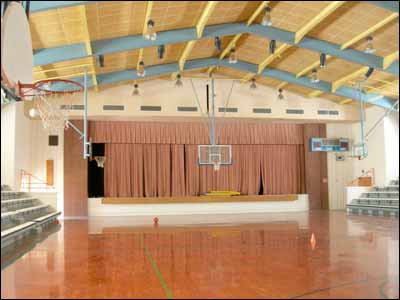
Our school gym, still handsome after all these years. The school was opened in 1956. City Hall sign: That's a nice-looking sign on City Hall. I hadn't thought of it before, but Gary Trotnic points out that the old City Hall -- the school building -- didn't have a sign saying "City Hall." And when your City Hall moves into a church building, it's nice to let those who enter know that although they're not necessarily any closer to heaven, they're still going to find nice people inside. Music and Pearl Harbor: While looking for the photo of the long-gone Skelly gas station, Leon Miller came across a shot of the Pawnee Rock High School orchestra from the early 1940s. (Both shots are on gallery page 5) He thinks the shot might have been made in 1941, judging by the apparent age of his sister, Corrine. "The reason this stands out is it reminds me of a very significant time in history," he wrote. "We all recall where we were on certain dates, 'When Kennedy was shot, when Nixon resigned, when the World Trade Center fell.' "The group in this picture was taking part in a band or orchestra competition at Emporia State Teachers College, in December, 1941. I travelled there with my parents and sister to attend the competition. We were standing on the steps outside some building when all of a sudden I heard people screaming, "PEARL HARBOR'S BEEN ATTACKED." Although I was only 8 years old at the time, I never felt any greater fear as I realized we were at war! "Sixty years later I had a similar feeling as I watched the World Trade Center towers fall on live TV!" Quarterly update: I've written before about my difficulty in collecting Kansas quarters. Well, someone out there has broken open the piggybank and set our silver-plated bison free. In the past three months, I've pulled four of the little darlings out of change. Grand total since the fall of 2005: 9. Job openings in Pawnee Rock[May 23] The city of Pawnee Rock is looking for candidates to fill three jobs: clerk, treasurer, and maintenance man. If the same person could handle both the clerk's and treasurer's responsibilities, that would be fine too, wrote city councilman Gary Trotnic, in response to my question. I had offered to post the city's ad for no charge. The jobs became vacant earlier this month when the former mayor dismissed the employees just before leaving office. Applicants should send their resume to the city building, 423 Rock Street. They may also pick up an application at the building. The building is easy to find -- it looks just like a former Methodist Church at the intersection of Rock and Pawnee Avenue, a block west of the post office. 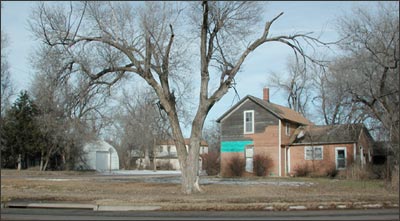
The old Drake house, viewed from the south in 2005. At one time, a Skelly gas station blocked this view. Farewell to an old house: Gary also sent along a photo of a house being dismantled along the highway; you may have seen it on the homepage. Many of us know this place as the Drake house. Although it once was a fine-looking place, it has been vacant for a number of years and gave people arriving from Larned a disagreeable introduction to town. According to the Barton County assessor's office, the property belongs to James and Shelly Corp, who should be praised for their decision to deconstruct it and perhaps use the land for a different purpose. For a number of years, a gas station stood behind it; it was Vickers and then Derby. Little known to many people, however, is the fact that there once was a Skelly gas station immediately south of the house. (See it here.) It's usually a tough choice on whether to tear down a bit of Pawnee Rock history dating to the early days of the 20th century, but it seems obvious in this case that the house was beyond rehabilitation, just in case anyone was willing to try again. I wish I could say it's the only house in town that should come down. Look at other towns: The ones that seem alive may have vacant lots, but they don't have many decrepit houses. I hate as much as anyone to see a familiar house go, but sometimes you just have to do it. Don Clapham: Don Clapham of Larned was our family mechanic for many years, working his magic at Don's Motor Service across the street north of where the Dillon's grocery sits. He died yesterday. I'll remember him for his pleasant sense of humor and willingness to explain what made my Plymouth Duster work. On the street, he was a fellow who would always wave. (Obituary) 35 years since the high school closed[May 22] This May marks the 35th anniversary of the last graduation at Pawnee Rock High School. It's a special anniversary, too, because of the sale of the school building this spring.
Pawnee Rock has had quite a while to adapt to the loss of the all-in-one school: The high school, the junior high, and finally the grade school were nibbled away by the USD 495 board in Larned. Sometimes I wonder whether I'm the only one who dwells on the death of the school; other people, I hope, have moved on to more productive issues. Still, the loss of PRHS was important to me because of when it occurred. I was in the last freshman class, making me fortunate enough to get a taste of high school here at that awkward age when everything means so much. (See the 1972 high school students and faculty.) Thirty-five years later, I have mixed emotions about the school's closing. It took me a while to admit that the closing might have improved my life. Lots of kids switch schools as families move, so maybe it's no big deal. But for those of us whose families had been Pawnee Rockers for three or four or five generations, changing schools meant a new way of life and creating an identity that no longer was built around who our families were or what our PRHS schoolmates thought of us. I was the first Pawnee Rock student to enroll at Macksville High, the day after the court ruled against us and Macksville's school district extended an invitation. Others followed quickly to MHS, and the remainder went to Great Bend or Otis-Bison or simply stayed in the Larned district. Here's what we gained: • We met new people -- fresh blood in our circles. Instead of one or two new people in our classes each year, we suddenly had 25 -- or 500. • We got out of Pawnee Rock, a town isolated between two county seats. At our new schools, the same old families didn't run -- or ruin -- everything. With the old castes out the window, we befriended whomever we wanted. • We all ended up at larger schools, meaning more opportunities for school plays, athletic teams, and class trips to France and better competition in academics. • We weren't bound by all we had been -- we could invent new lives for ourselves. Almost all of us realized the opportunity to do more than we had done before. Old animosities and rivalries faded away as we stopped beating up ourselves; bullies of both sexes who had spent years instilling fear in underclassmen lost their advantage. • And we had the advantage of facing all these changes while still being able to call Pawnee Rock home. Those who embraced change succeeded. And that's life. Our tough townIt has been said that the loss of PRHS was the beginning of the end for the town. We of my generation often say that because it happened during our time and we'd like it to be that important and make us more important by association. There's no way around this point: When the high, junior high, and grade schools closed, the loss of each of level was one less reason for families to live in Pawnee Rock, one less connection to our shared history. Our town lost its main public symbol and the big reason Pawnee Rock's name got into the papers every week: sports. The town had had a high school since 1914. Jobs were whittled away: teachers, bus drivers, janitors, cooks, secretaries, coaches, the librarian. More time and money were spent on getting kids to school in other towns. But in the big picture of Pawnee Rock, other losses were also important over the decades: The newspaper closed. The two banks closed. Many elevators closed. The lumber yard closed. The grocery store closed. The highway gas stations closed. The salt plant closed. The American Legion closed. The mercantiles and implement dealer closed. The welder, the carpenter, and the dress shops closed. The truck-bed shop closed. The drug store closed. The livery stables closed. The auto garages closed. The depot closed. The Methodist Church closed. The bars and restaurants closed. And yet life goes on, with new businesses and commuters, and the town refuses to blow away. To the degree that Pawnee Rock has adapted to change, it has succeeded as a community. Bach to the future[May 21] The organ in the Mennonite sanctuary was a fine instrument and during my years there it was played, if I remember right, by Velma Schmidt and Marilyn Smith on alternating Sundays. The ladies' hymns filled the big room, the resonating chords making even the blandest melody noble. On Easter and Christmas Eve, especially, we heard the angels sing. Organ music also came over the AM radio. At 8 o'clock on Sunday nights, KVGB in Great Bend granted us an hour of classical music, which often included a piece of organ music written by Bach. The music was thick with chords and scales and melodies and counterpoint, and it was unlike anything our school band or the church organists played. I kept the music in my head. When I mowed the cemetery or rode my bike, Bach rumbled around between my ears, a phrase here and there adding a baroque edge to the browning landscape. It wasn't Porter Wagoner or Merle Haggard; it was alien music in our familiar land. At first, I was a little shy around organ music. Organs were from church, so I figured that all organ music was church music. I felt preached to and somehow unworthy to listen, an emotional response that probably made the music much more memorable. Over the years, however, I came to suspect that the stuff had a religious theme because the Catholic Church had paid the composers in currency, recognition, or a ticket to heaven. And composers are like anybody else -- they want to please the only buyer for their goods. Now that I'm more worldly than I was at 16, I think the composers used their complex genius with as much happy cynicism as a modern-day country-music singer who produces flag-waving melodrama to pay the bills. I love classical organ music for what it is. If there's a religious message, it'll speak to me; if it's just a beautiful piece of music that reminds me of a line of thunderstorms sweeping across the plains, there's a message in that, too. Yesterday I took our 11-year-old, Sam, to an organ recital at the enormous new St. Andrew Catholic Church here in town. He is shy around crowds, so we suggested that he take a science encyclopedia that he could duck into, which he did. Until the first chord shook our chests. Sam jumped, and then he was riveted. He had heard the organ produce church music, but this was different. It wasn't music to sing to; it was alive on its own, curling and twisting and marching and thundering. Sam had never before sat still for two hours -- much less two hours on a hard bench. I didn't expect an organ recital to be a bonding moment, but there it was. Now the music lives in Sam's head. J.S. Bach's Prelude in E Flat has come to a new generation. Library books: In case you were wondering what has happened to the Pawnee Rock city library, it's in a safe place -- in boxes in the basement of the old Methodist Church, which is the new city building. Over the past four decades, the library has been in at least four buildings: the old red-brick city hall/fire station, the building just west of the post office (previously the drug store and a dress shop), the Santa Fe depot after it was moved downtown, and the school building. Storm damage last year soaked many of the volumes, which spent the summer on tables and the floor drying out. Let's wish the new library a safe and happy home for a long time to come. Old News from Pawnee Rock[May 20] The Pawnee Rock Community News, published by the Ministerial Alliance, has for many years been the string holding our hometown together. Here's a bit of news from edition No. 123, dated January 12, 1995. Community CoffeeSaturday, 8:30-10:00 a.m. at the Depot. Bring your cup and come visit with your neighbors. January Calendar of Events at Pawnee Rock SchoolJan. 12 Basketball Game at Macksville -- 5:00 p.m. End of first semester. American Legion Soup Day SupperThe annual Kansas Day Soup Supper, sponsored by the American Legion Auxiliary, will be held at the Legion Hall on Jan. 28 from 4:30 p.m. to 7:30 p.m. Tickets may be secured at the door or from Auxiliary and Legion members. Vegetable soup, chili, relishes, crackers, homemade desserts and coffee will be served. Senior Center mealsMon.-Fri 11:30 a.m. Seniors $1.75. Those under 60 $3.00. Call Linda Sutherland the day before you wish to attend or before 8 a.m. that day. Methodist Church Ground Hog DayWaffles and sausage will be served Sat., Feb. 4, from 11:00 a.m. to 6:30 p.m. at the Methodist Church. There will also be a bazaar and bake sale. The quilt drawing will take place at 6:30 p.m. New Jerusalem ChurchRev. Galen Unruh of Hutchinson preached here on Christmas Day. On December 26 Tricia Walker and Timothy Galliart were married at the church with the Rev. Galen Unruh officiating. Rev. Eric Zacharias of Pretty Prairie will preach at the New Jerusalem Church on Jan. 22. There will be a carry-in dinner following the morning worship hour. Everyone is welcome to attend worship and the meal. Mennonite ChurchThe funeral service for Ethelena Smith was held Tues., Jan. 10. Ethelena was known to many in the community as she lived in the Pawnee Rock area most of her life. In the last few years she lived at the high-rise in Great Bend. We will miss her. This is the year for the Easter pageantEaster is coming April 16. Plans need to be made to give the Easter Pageant. Linda Slavik has consented to direct the pagent but she needs volunteers. Please call Linda if you are willing to fill a role in the pageant. Elaine Mull has consented to direct the pageant choir. LET'S GET BEHIND THE PAGEANT! A photo I like: No. 37
Roger was a big wheel in Larned. I think he ran a furniture store; maybe it was Tabler's. He was always doing something for the chamber of commerce, and I wouldn't be surprised if he was the mayor or a member of the city council for a while too. Roger was a good guy. He always wanted something, but he was nice about it and willing to trade you something for what he wanted. That came in handy when I was a reporter for the Tiller and Toiler. I think he did have a good heart for Larned. He was a cigar smoker, and he confidently wore suits that have never come back into fashion. I made this photo at the dedication of the Santa Fe Trail Center during June 1974. It just was right to find Roger standing alone in the hot sun, burning a cigar in the wind. Lost house is found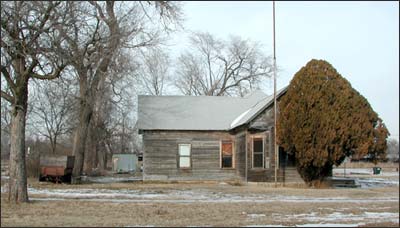
Ruth Ann French Sessions identifies this house, built around 1900, as the one Don and Wilma Chapman owned. The photo was made in January 2005. [May 18] A week ago I asked our Pawnee Rockers to help Laurie Chapman find the house once owned by her grandparents, Don and Wilma Chapman. This information-packed reply came from Ruth Ann French Sessions. Ruth graduated from Pawnee Rock High in 1962 and now lives in Louisiana. You know, it's great to get such an overview of a house -- and of the families whose histories were entwined in it. I was surprised by the mention of Roger Unruh's family, too. It makes me wonder how many strands of history -- love, death, mystery, housing, and even something as simple as a lily garden -- connect us all. Here's Ruth: "Don and Wilma Chapman lived across the street from my grandparents (Ruth and Earl French), whose home was on the corner of Bismark and Houck. The Chapman house faced Bismark. "The house was originally built around 1900 by my great-grandparents, Peter and Flora Miller Bloom, when they retired from farming and moved into Pawnee Rock. They originally lived east of PR in a large farmhouse, which they later sold to the parents of Roger Unruh, longtime PR postmaster. Peter Bloom died in 1952 at the age of 97 and the Chapmans purchased the house from his estate. "I have some vague memories of the house as I was a very small child when my great-grandfather died. I do remember the beautiful yard, as Peter Bloom was a wonderful gardener and had planted many trees and flowers. The Chapmans later extended the front porch and I remember my grandmother being terribly upset when they poured concrete over a bed of lilies of the valley that were planted in a bed to one side of the porch. "I believe Don Chapman worked as a welder, and Wilma was always available to 'help out' with cooking, cleaning, etc. whenever a family would need her services, especially when there was an illness or a death in the family. I was a child when Wilma died as a result of burns from an explosion that I believe occurred as she was trying to light the hot water heater in the cellar of the house. My grandmother always described her as 'having a jolly laugh.' "Wilma Chapman's was not the first death associated with the cellar, as my great-grandmother Flora Bloom sustained a severe head injury when she fell down the cellar steps and died not long after this accident. "After Wilma's death the house feel into disrepair and eventually became uninhabitable." Spiraling into a sunflower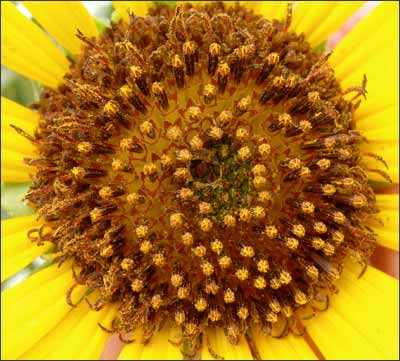
This sunflower, with an easily visible spiral pattern, grew happily in a ditch east of the Pawnee Rock cemetery in the summer of 2006. [May 17] If you're so smart and if I'm so smart -- in fact, we're as sharp as fishhooks -- why didn't we figure out the pattern in a sunflower? Julie Rehmeyer has published an article, "The Mathematical Lives of Plants," in Science News that explains how the little flowers inside a sunflower's big center are aligned in spirals, both left-handed and right-handed. And the patterns are further revealed to create a golden angle, the theoretical perfect balance within a circle. It's not just sunflowers. The next time you're under a pine tree, pick up a cone and look the seed flaps. We see patterns all the time: tire treads, rows in a field, power poles along the highway. I'll be the first to admit that I've never tried to articulate what I observe, but I'm glad someone has. Who knew our Barton County ditches were full of mathematical glory? Pawnee Rock in the news: The top photo (today only) in the Great Bend Tribune this morning shows a car whose driver is going to have some explaining to do. Reporter/photographer Pam Martin caught the action. Fantasy writing[May 16] This week I'm judging part of our newspaper's writing contest, weighing earnest tales of fiction written by fourth-, fifth-, and sixth-graders from across the state. It's an annual event open to fiction, nonfiction, and poetry composed by youngsters and adults, and this is my fifth year of judging. Generally, I volunteer to work in the age group my sons are in (I don't judge any category they enter) so I can get an idea of how that group's collective mind works. Sometimes the stories are fanciful -- there are flying dragons, girls on ponies, and witches guarding secret wells. Still, this age group must be where life gets difficult, because many stories culminate in the sorting out of friendships or the delivery of bloody justice. I remember that age in Pawnee Rock a little differently; Zorcons with swords weren't part of it. If there were any "fun" writing contests back then in central Kansas, they weren't introduced to us in grade school. In fact, we had just the opposite. We wrote about drugs and citizenship, two subjects we surely couldn't have cared much about. Seventh grade brought us weeks of anti-drug instruction and paranoia about hippies. We wrote serious little contest essays for Bernard Williams' class, and anyone whose parents would take them was invited over to the First National Bank basement in Larned, where we read our messages of perdition into a microphone to be broadcast over KANS to what must have been a thoroughly uninterested audience. I can't imagine that we inspired anyone to walk the straight and narrow. It was good public relations for the sheriff and the radio station, though. The contest wrapped up with a revival-style meeting at Larned's old civic auditorium next to the old library across from the courthouse. Ida Deckert, one of our own, was given the award. In eighth grade, a couple of us won certificates for writing about citizenship. The exact topic is gone from my memory, but those topics are really all the same. (Be in favor of voting, or of the flag, or of the military, or against unions.) Classmate Kevin Dougherty claimed a first place, and I received a second. We and a few kids from Larned and Pawnee Heights got our school mugshots published with an article on the front page of the Tiller and Toiler. Somewhere I have a copy of that Tiller. It's not so much a trophy as it is a marker of eighth grade; a county-seat paper sells extra copies by publishing lots of pictures of kids, and it was my turn. Still, someone read my essay and liked it enough. That makes me feel good even now. Now that I'm one of the faceless adults reading through a stack of kids' stories, I feel frustrated that I can't praise every student who enters. Some of the stories are awful and some are really sharp, but every one of them was crafted by a student who was confident enough to commit the tale to paper. The kids are thinking. The kids are all right. The writers who win their categories in my newspaper's contest will have their picture published in the paper, right next to their winning entry. A few years ago, the 11-year-old essayist I helped pick to win her nonfiction group was also named the overall winner. The boys and girls who win will never know whether their story was great or just good enough to beat the others, and I don't imagine they will think to ask. I judge carefully, however, because with our choice of one story over another we're going to change a young writer's life. A real writer: Pawnee Rock native Cheryl Unruh had a good column about Greensburg yesterday. She also taped a version being aired today on Kansas Public Radio. Happy 50th anniversary: Merita and Milton Rice, 40-year residents of Pawnee Rock, will celebrate their 50th anniversary at a party this Saturday in Great Bend. Coincidentally, there will be a 50th anniversary party Sunday in Rozel for Don and Carol Ellis, the parents-in-law of Susan Unruh Ellis, who grew up across the street from the Rices. (Announcements for both couples) When junebugs had names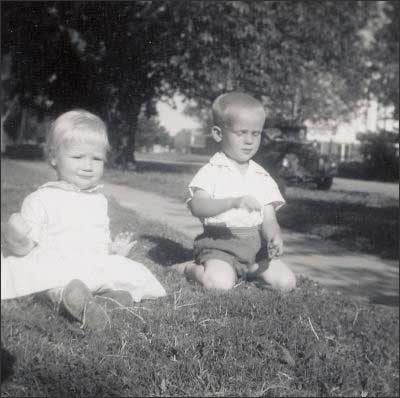
Cheryl and Leon Unruh in the front yard, 1960. Behind us are the giant elms, Dad's pickup on Santa Fe Avenue, and the Christian Church. [May 15] Once upon a time, long ago in a town called Pawnee Rock, there was a three-year-old boy who: • Was excited by new teeth. • Couldn't walk all the way across town because it was too far but liked it when Dad carried him. • Had no idea what it was like to fall off a bike or out of a tree. • Got to pick out building blocks for his little sister. • Hadn't yet tumbled down the basement stairs. • Wore good clothes on a summer evening so Mom and Dad could take snapshots that he would see 47 years later. • Hadn't yet pulled the wings off a butterfly. • Probably hadn't been called an ugly name. • Played all morning in the front yard and all afternoon in the back yard. • Loved to look at the pictures in "The Little Red Caboose" and all the Little Golden Books, especially when Mom read them out loud. • Thought you could fly if you jumped high enough. • Got up on his knees to see out of the Chevy. • Would wait two more years for his first pet, a dog named Tippy. • Thought boys played with dolls, and hadn't yet touched a gun. • Gave names to junebugs. • Thought every building in town was very, very big. • Believed what he was told. • In two years would have kindergarten friends all over town. • Didn't know anybody who had died. • Never dreamed that he would live anywhere but home. • Survived all this innocence and grew into a man so he could read "The Little Red Caboose" to his own sons. Spring cleaning in a big way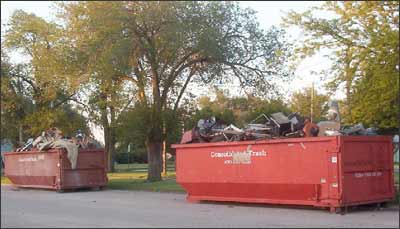
Two bins of trash collected by Pawnee Rock residents during the citywide cleanup await hauling at the city park. Gary Trotnic, one of the volunteers, took this photo. [May 14] Saturday was the start of a big week in Pawnee Rock -- the citywide cleanup. The cleanup will continue through next Sunday. Alita Felts and Gary Trotnic sent a few paragraphs and some photos of the prodigious effort. Alita wrote: "Saturday morning the Sun was up in old Pawnee Rock and the citywide clean-up had begun. The two red dumpsters were in place. One dumpster was for metals and the other was for trash and debris. The people came and dumped and dumped! "City Council member Gary Trotnic was posted near the dumpsters to aid and direct the traffic as they frequented the dumpsters. By noon the first dumpster was full and they came to take it away, bringing yet another to take its place. By 5 p.m. both of the other dumpsters were filled past their capacity. "While all of this was going on two volunteers (Kathy Bohn and Wayne Gore) arrived in the sweltering heat (must have been near 90 out there) on their trusty riding mowers. These two volunteers lassoed the grass and tamed it in no time! Also off and on all day long as the cars came and went some of the younger generation would appear on the scene from nowhere and helped out what they could! "It was a heart-warming scene to watch the people of Pawnee Rock working together to clean up our community. ... "This next week some of us want to go door knocking to check if there are residents that will need help getting things down to the dumpsters. ... We do have volunteers that are willing to help in any way they can to accomplish this goal!" City council meeting: The city council has called a special meeting for 7 o'clock tonight at the city hall/former Methodist Church. The sale of the school and catching up on old and new business will likely be the most interesting items on the agenda. This is the council and mayor's first meeting since the change in government last week. Speaking of the Methodist Church: Marsha McFann Bouker, a Pawnee Rocker who now lives in Hays, wrote to lament the church's fate: "It saddens me that the Church I used to sing with my Grandmother in has become city hall. ... I guess it is better than sitting empty, but never the less, I have a lot of memories of funeral dinners and Christmas pageants in my beloved Methodist Church." Wesley Howerton: Wesley Howerton, the son of John and Anne Wilson Howerton, has died in Dodge City. He was 67. He married Joyce Lawrence in Pawnee Rock and had been a teacher and school administrator in several western Kansas towns. His funeral is today in Dodge. (Obituary) Kool-Aid pickles: I wrote last week about marinating dill pickles in a mixture of Kool-Aid and sugar, giving them a new taste and bizarre color. Ray Randolph of Indianapolis wasn't quite ready to follow me to the refrigerator: "I have not (before now) heard of Kool-Aid pickles. Of course, there are a lot of things I'm unaware of. The first thing I thought of when I read your piece was the grand green ketchup experiment by the HJ Heinz Co, which came to naught. "I always thought my use of peanut butter on pizza was a little out of the ordinary, but you trump me with your latest delicacy." I wrote back to ask Ray whether the peanut butter replaced the tomato sauce. "No," he answered. "Just a little bit of PB on top around the edges." Sounds good. Well, now I'm hungry for a sandwich of peanut butter and pickle slices. See you in the kitchen . . . Searching for Mom's garden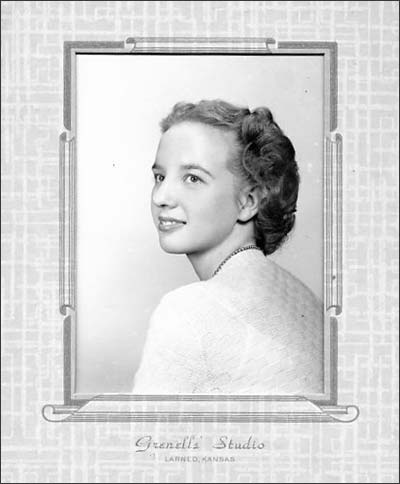
Anita, in her Larned High senior photograph [May 13] When I was a freshman at the University of Kansas, my political science teacher quizzed each of us about our upbringing. It was clear, studies had shown, that fathers had the greatest influence on a child's leanings. But there was no equivocation for me. Mom was, and is still, my political conscience. Our mom, Anita, was born at Viola, a northern Arkansas town that's close to a few places you might have heard of and closer to a lot of places that put the "back" in "backwoods." She and her two siblings and her parents, both teachers, eventually moved to Radium and to Larned, which is where Mom graduated from high school and met Elgie, the man who would become our dad. In the 1950s, she bore me and then Cheryl. Dad grew up north of Pawnee Rock. As an adult he lived in town until he was almost 80, and now he and his second wife, Betty, live in Great Bend. His worldview is basically of central Kansas. That works for him, and he's happy with that, and I probably got my affection for rural Kansas from him. Mom, however, was from a different world, a place where teachers made a small wage while improving the lives of those who were more impoverished and where even in the 1960s men plowed fields behind a mule. She showed us that version of the world and encouraged us to see it through the eyes of the people who lived in it. After the divorce, she moved from Pawnee Rock to the big city and earned a degree in social welfare from Wichita State University. She remarried, and when she moved to Tennessee and Georgia and now back to Arkansas she used her education to make the world better. But I suspect she would have done that even without a degree. Mom, who has a keen eye for wildflowers, tried hard over our first two decades to teach Cheryl and me the difference between this plant and that. I think that, in the part of Kansas where respect often is given only to plants that grow in straight rows, she was encouraging us to see the beauty in plants that grew where they could, where they wanted to, or where it was natural for them. I can't say that Pawnee Rock was Mom's natural habitat. I think she has found it now amid the dogwoods and purple wild iris and rocky hillsides of the Ouachita Mountains. Mom still keeps me supplied with sassy liberal newspapers, books by Presidents Clinton and Carter, and Internet-born jokes about people who can't see past their billfolds and Bibles. Her own church preaches -- and lives in -- unity with the world. Alice Walker, who is most famous for writing "The Color Purple," also wrote this: "Guided by my heritage of a love of beauty and a respect for strength -- in search of my mother's garden, I found my own." Mom, I won't accuse you of making me what I am today; no mother should bear that burden for her children. Still, you set me on my feet and helped me see the world as it really is -- and as it could be. The world is a beautiful untended garden of wildflowers. Happy Mother's Day, Mom. Closer to home: Happy Mother's Day to my wife. You're the best. You never seem to get tired of listening to the boys explain NASCAR, and they'll really understand in a few years how good a mom and teacher you are. More moms: And, finally, Happy Mother's Day to all of Pawnee Rock's mothers. You've done well. A photo I like: No. 36
[May 12] During the summer I worked for the Hays Daily News, I drove around the countryside on my days off. "Exploring" was my escuse, but I was really looking for trophy photos. On this day, I came across some cattle standing in a pond not far from the road. After making the most of that scene, I rested on a chunk of limestone and, within a couple of minutes, noticed that I wasn't alone. This frog had the best of both worlds . . . or at least as good as it gets in July in Ellis County. It had water and the only shade for a hundred yards. And if the frog could get up the energy, lunch was also available. I like this photo because it reminds me to slow down. Sometimes the best shots are right in front of me. Showdown -- and hope -- in Pawnee Rock[May 11] As you can see from this story (big file: 191k) by Pam Martin in Wednesday's Great Bend Tribune, Pawnee Rock is poised for a great step forward.
This is a great opportunity for Pawnee Rock. If the school deal goes through, there will be money in the bank. When the sewer plant is finished, the state may be off the town's back. When the new elevator is finished, the town's biggest property holder will be in even better shape. After moving to the former Methodist Church, the city government has a city hall it can afford to heat and cool. And Pawnee Rock is still about halfway between Great Bend and Larned, making it a good place for families and commuters. There probably are some hard feelings over the election; it's that way in nearly every town after every election. That's not always bad, because it shows people care in a time of hard choices. We who live in town and we who live away want more than anything for Pawnee Rock to simply be a good place to live. If the town's leaders -- elected and otherwise -- keep their eyes on the town's greater good, Pawnee Rock has a shining future. Someplace to eat: I've mentioned this several times before (and I concede that I'm not living in town and so my advice may be worthless), but I'd love to see a restaurant in Pawnee Rock. Not just a place that sells burgers 'n' fries in a plastic basket, but a cafe that will lure people off the highway and bring them out on a Wednesday night from the county seats. Put a billboard up on the highway on each side of town. Play up our town's history. Make it a destination! I think such a restaurant would help give Pawnee Rock a focal point, as well as jobs and cash from outside. Anna Marie McGuire: Please welcome a new Friend of Pawnee Rock, Anna Marie McGuire. You may have gone to school with her in the 1940s and 1950s. A voice from the storms: Brenda Wycoff Mercer, who grew up at Radium and went to Macksville High in the 1970s with many kids from Pawnee Rock, is a registered nurse at Stafford District Hospital. (She's also the niece of Pat Croff and Bob Wycoff, two Friends of Pawnee Rock.) She gave permission for PawneeRock.org to print the note she sent to relatives explaining what it was like a week ago tonight when the storms came through Kiowa, Stafford, Pratt, Barton, and Rice counties. "Hi! We have had a horrible weekend. We are all OK. We spent much of the weekend in the basement because of the dreadful tornado storms that repeatedly came across our area. The town of Greensburg Kansas was 95% destroyed. Only 8 people died there so far. "Many farms in Stafford County were hit and destroyed. Some of the places only have a foundation or basement left. We went to our basement when it was about 10 miles away. Then another report came over the scanner that it was 2 miles west of St. John and headed towards Hudson and was a mile wide. We were scared to death because we were right in line. "I was really praying for us to be protected. It hit our shelterbelt (tree row) 100 yards west from our house and more trees 100 yards north of our house. Our house, animals, machine shed and barns are all OK. That was Friday. "Saturday, because we had no electric, Todd said I could eat supper with them, shower and stay all night because they had electric (Gary had to work). We spent the entire evening in the basement. Because three big storms started with tornados in Greensburg again followed the same path and came up to the Radium/Seward area. One right after the other. They were all around Todd's house but nothing hit his property or house. He got 6.75 inches of rain that night and 3 inches the night before. "When I was going home in the morning I saw where a big (mile wide) tornado had went through four miles east of his house. It started by Greensburg (like the night before) and destroyed houses and property clear up to Claflin/Hollyrood area (that was the Saturday night tornado). It did major damage. It went also about 4 miles from my house. The Friday night tornado was a F5 the strongest possible and traveled around 174 miles. "Now we are having a LOT of flooding. Sunday Radium and Seward had to be evacuated because of flooding. At Macksville highway 50 was shut down because of flooding. The road in front of my house was a river and still had water running across this morning. Todd did not lose any pivots (irrigation systems), but he did have quarter size hail. Around Dillwyn and Macksville nearly all of the pivots are turned over. My electric finally came on Sunday afternoon. "One of our storm spotters was hit by the Friday tornado. His car looks like a pop can that has been stepped on. He is still in extremely critical condition. "I helped with a Red Cross shelter Friday night and may go help with the shelters in Haviland (for the Greensburg people) if they need me." Kool-Aid pickles[May 11] You might have been brave enough to eat a pickled egg plucked from the big jar on the counter at Betty's Cafe. You might have eaten pig's feet straight from the jar at home. You might have been the one who grabbed the gizzard when Grandma brought out the fried chicken. Or the sliced beef tongue served on a plate with tomatoes. I wasn't the one. Dad and some old guys who grew up on farms were. Times change, however, and I guess I've turned into one of those guys who eats things you don't want to think about too much. I like tongue tacos. I eat fish besides fish sticks. I would happily decorate almost every meal with jalapeno slices and wash it down with beer that isn't yellow. But my family, who think my tastes are extreme, are aghast at what I think is a great idea: Kool-Aid pickles. These are regular dill pickles marinated in double-strength Kool-Aid and sugar until they're the color of, well, something else. Apparently they're all the rage among kids in the Deep South. I broached the idea last night after work. I found out that my wife still hasn't forgiven red dye No. 2, and the boys think any pickle color but green is just wrong. Still, Sam seemed to be willing to give it a shake once he learned the pickles would be both sweet and sour. You know, if Glen Carris had had a jar of big red pickles at the checkout stand in his grocery store and if the gas station had sold blue pickles, both of those places might still be in business. After all, kids shouldn't have to live by Slim Jims alone. Clowns, disaster, and history
[May 9] She grew up in Pawnee Rock as Pat Wycoff, and now she lives in northern California. Pat Croff says she's "alive, well and still kicking," and after seeing this photo, I believe it. Pat (on the right) and her neighbor, Sheila Hayes, were an effervescent part of the Shasta City Damboree this past Sunday. "We had a great time running back and forth across the street to visit with the children," Pat wrote. "Not bad for a 75-year-old lady!!!" Greensburg photos: On a somber note, Mandy Sheldon of Gardner recommends a visit to a Wichita Eagle photo gallery of the devastation in Greensburg. "These photos really tell the story," she wrote. Go get 'em, Governor: It was good to see Governor Sebelius make the news with her challenge to the White House over the lack of National Guard equipment. The added attention may help Kansans, including victims of the whole disastrous weekend in several counties, get more aid sooner this time and especially next time. Barton County had 10 tornadoes over the weekend, writes Dale Hogg in the Great Bend Tribune. We were lucky that none came closer than they did to Pawnee Rock. There's also a sad story about the Macksville police officer, Tim Buckman, who died of injuries inflicted Friday by a tornado. Photographic memories: Leon Miller of Dallas wrote about a couple of photos that appeared recently on the homepage and that now are in the photo gallery: [City Drug Store and Herald job shop] "When I was in junior high (as we called it back then -- 1946-47), the building on the left in the picture, with the arched entrance, served as the school lunchroom for the junior high school kids. It may have been for the rest of the school as well but I remember running from the high school down Pawnee Avenue to get in line for our lunch. I don't know the reason for this setup, other than this was an early form of physical exercise to get your appetite up for lunch. How would it be today if all kids had to run a couple of laps before they could have lunch? CHILD ABUSE! CHILD ABUSE!" [House on Cunnife burns, 1940s?] "I don't think the fire truck was from Pawnee Rock as there was no city water supply at the time (it came along in the '50s). Some houses, including ours, had their own electric pumps for personal water supply, with the remainder of the community having only hand pumps, either inside or outside the house, or both. As mentioned in earlier articles, when a fire occurred the community formed a bucket brigade from a pump and poured the water in a pressurized vessel that sprayed the water to the fire. "The boy in the foreground of the picture reminds me a lot of Millard Barrett who was a fellow classmate." Leon's an observant fellow. The writing on the fire truck, which is difficult to read online but clear on the original print, says "Great Bend Fire Dept." Which house was Don Chapman's? Laurie Chapman, a Stafford County native who now lives in Florida, would like some help figuring out which Pawnee Rock house her grandfather, Don Chapman, lived in. She remembers that it was white with peeling paint, and her grandfather lived alone for many years after her grandmother's death. Got the answer? A bird in the mind: All of us young ones in Pawnee Rock used to take trips somewhere, I imagine, and those trips imprinted our young brains with details that finally work their way back into our lives. Cheryl Unruh wrote a nice column about going to our grandparents' place in Arkansas. New mayor, council take office[May 8] Pawnee Rock's new city council has been sworn in. The leadership changed hands at Monday evening's meeting. Thank you to the departing mayor, Jack Link, and council members Merita Rice, Richard Lohr and Shane Bowman. Stepping forward to lead a city is not an easy task, and your many hours of work are appreciated. Welcome to the new mayor, Mike Kirkman, and new council members Gary Adams, Joseph Billus, Timothy Parret, and Gary Trotnic. Walt McCowan remains on the council. Kirkman had been on the council, and Gary Trotnic (who had run in the April 3 election) was appointed to fill Kirkman's spot. Two of the departing council members and mayor ran write-in candidacies after choosing not to put their names on the ballot, but none was retained. Gary Trotnic and Alita Felts, who occasionally send us updates and photos of Pawnee Rock news, sent this note about what sounds like a memorable evening (as we've seen before): "We had the city council meeting tonight but nothing was discussed per the sale of the school. "During the discussion of the old business it was discussed the evaluation of the city employees. Immediately after that, outgoing Mayor Link fired [city clerk] Konny and [maintenance supervisor] Rick Trinka for no reason. Their separation was to be effective at the end of the old business! "They had a 15 minute executive session to discuss their severance pay. The last thing in the old business was the city attorney resigned. "Since we had no city clerk, the old mayor and city council left. ... "The new mayor and city council anticipated this would happen so they went to Great Bend last week and got sworn in there! Gary Adams got up and announced that they all had been sworn in prior to the meeting so they could legally take over the meeting from there. "First thing they discussed and voted on was to appoint (myself) Gary Trotnic to replace Mike Kirkman's position on the council. It was discussed that MidWest Energy take over the gas system. Also a citywide clean-up was discussed for later this month. "Since we have no city clerk, Gary [Trotnic] will go over to Great Bend to be sworn in tomorrow. "There were two reporters present at this meeting as was Sheriff Buck Causey!" Got news or ideas? PawneeRock.org is open to everyone who wants to send news, photos, or ideas about the way things are going -- or should be going. We'd like comments to be constructive and fair, because this is our hometown. To speak your piece or add to our photo gallery, send your words and pictures to me at leon@pawneerock.org. Storm damage: The Great Bend Tribune has a couple of nice stories today about flooding near Great Bend and tornado damage in Macksville, 20 miles south of Pawnee Rock. Some of the names will be familiar to Pawnee Rockers who went to school there during our diaspora. Watch the river rise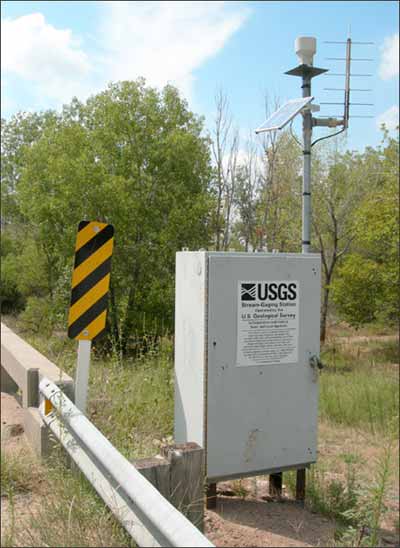
[May 7] You've probably noticed the big silver box at the eastern end of the O'Rourke Bridge south of Pawnee Rock -- the box with the "USGS" label on it. That box is connected to sensors in the riverbed that measure the flow of water, and then the solar-powered box broadcasts that data to a computer somewhere else. Normally, the sensors could just sleep through the day, but now they're busy. Go here to check on the water flowing at the O'Rourke Bridge. I was impressed by the spike that started Saturday. Scroll down far enough, and you'll see that the storms starting Saturday left five inches of rain at this box. Here's the river at Great Bend. Click on any of the little dots on this map to see the water levels across the state. Black dots mean flooding. Flooding on flat land[May 7] One of my early memories is of being taken the Arkansas River during the flood of 1965, I think it was. Dad drove his pickup out on the asphalt road, and we and a dozen others watched the river near the Nairns' place -- a quarter-mile from the normal riverbed. Being a kid who had heard radio reports that "the river will crest" at a particular height, I had pieced together a theory that a flood appeared like a tsunami, a wall of turbulence rushing down the riverbed. Instead, and more appropriately for a broad valley such as the Arkansas', the flood came like someone was filling the bathub -- rising slowly and inevitably. But it was a lot dirtier. The brown water swirled through the grass-laden barbed wire fences. It chewed at the road as it swept over, and eventually it tore out part of the bed. We watched some fool try to drive up to the bridge, but he lost his nerve and retreated. When we drove around to the east side of the river later that evening or the next day, we could walk up to the Pawnee Rock bridge -- or what was left of it. The eastern third had been knocked out by water pressing against tree trunks lodged against the wooded pilings. Now, Ash Creek often flooded, pouring its water down the big ditches directly into Pawnee Rock. Our basement had floodwater a time or two. But a river flood was something else. And this week Pawnee Rock finds itself with another historical event washing up at its curbs. Shutterbugs, have you been out recording history? In other news: The Wichita Eagle mentioned the highway closure from Pawnee Rock to Ellinwood in Sunday's online disaster coverage. Green skies and Greensburg[May 6] Some people live in big cities where murder is frequent. Some live in earthquake areas. Others live in the path of hurricanes or in places where it floods year after year. But none of those people is as brave as someone who lives in Kansas on purpose. We -- Kansans and those who have left -- watched the Weather Channel or some website's weather radar Saturday, staring with morbid fascination at the big red infections rising again and again from southwestern Kansas. We stood in spirit with those who stood on their porches and faced storm after storm, not knowing whether the next tornado would be theirs. There were times when three projected storm tracks crossed over our town at the same time. If all Pawnee Rock suffered was broken tree limbs, hail-dented cars, and a foot of water over U.S. 56, it's the luckiest town in tornado alley. We know many other towns came close to disaster this weekend, and it may happen again today. Greensburg, Haviland, Trousdale, Macksville, Dillwyn, St. John, Radium, Seward, Dundee, Great Bend, Dartmouth, Ellinwood, Claflin, Holyrood. And you can be sure there were nervous stomachs in Hoisington, where the brick houses up by the hospital still have that shiny-new look. And Greensburg, poor Greensburg. Greensburg is one of those towns that for us was out of the way, the kind of place we wouldn't visit unless we went on purpose. And a lot of us did, driving out on a Saturday or Sunday when our folks wanted to show us something interesting. You know you've seen "Kansas" when you have peered over the edge of the World's Largest Hand-Dug Well and pondered the thousand-pound meterorite. In a part of the state notoriously short on trees, it was an oasis with grain elevators and steeples. I was in Greensburg three times: Once as a grade-schooler with my parents and sister (only Dad had the guts to go down the well), once by myself when I rode my bike through on a trip from Austin to Pawnee Rock, and again in the mid-1980s when I drove out from Wichita to get reacqainted with southwestern Kansas (I went down the well). On that last trip, I went first to Liberal, which fancies itself as the home of the Yellow Brick Road. It'll be interesting to see, over the next couple of years, whether Liberal continues to hawk the Wizard of Oz theme in its civic advertising. Maybe Liberal will show some respect for Kansans to the northeast. People will still go to Greensburg, however, first to pretend to marvel at the Pioneer Spirit of the Hardy People of Greensburg but really to see the damage and to shiver with that semi-pleasurable feeling of "better them than us." But later, Kansans will go to Greensburg and really will admire those who stayed and rebuilt. I don't mean to be flip about this, because we who have seen storms sweep across the plains can imagine ourselves in Greensburg's place. A lot of Kansans will help Greensburg recover. I suspect that within five years there will be no stronger town than Greensburg. Its residents will know something about themselves that I hope the rest of us never have to learn. The only place to read all about it: My sister, Cheryl, updated her Flyover People blog for several hours with a detailed record of last evening's breaking weather news. Reading it all at once is like watching a disaster movie unfold. The Wichita Eagle did a dandy job of covering the storm. The Hutchinson News, which used to own southwestern Kansas, hasn't quite caught up the Internet age and didn't have any of its own coverage available online. Even the Dodge City Globe, backed by the national Morris newspaper company, didn't find the wherewithal to update its news during the day -- on a once-in-a-lifetime national-interest story that happened 30 miles away. The Great Bend Tribune put its electronic head in the sand and passed up an opportunity to be helpful and informative Saturday, not even updating its site when funnel clouds were rotating over the city and when damage was occurring all around. Tornado watch[May 5] Today, I'm like the rest of you -- keeping an eye on the weather radar. I've been watching storm cells develop and play out as that ugly red line marches to the northeast past Greensburg and Larned. Last night's storm's series of twisters didn't hit Ellinwood as hard as first reported by the wire services (and thus by me), thank goodness, but it did leave quite a bit of damage in Claflin. At this point, the death toll is nine. It was frustrating early today (3 a.m. Central time) to watch CNN's talking head blather on with a meaningless rehash of celebrity news when there should have been something about Kansas' tornadoes. Part of that was that the Kansas AP and the larger newspapers weren't feeding the wire service or updating their own websites. There's plenty more detail available today, of course, as daylight came and helicopters and light planes could fly in with camera crews. You'll also hear mentions that our old South 50-6 League partners Mullinville, Bucklin, and Haviland are helping out in a big way. The Wichita Eagle's photographer, Marc Benavidez, did a great job of relaying the vastness of the damage in Greensburg. His photos will be used nationwide in Sunday newspapers. One of the Eagle's reporters, Stan Finger, grew up outside Rozel, so he has a good idea of what it's like to live on tabletop farmland during tornado season. Channel 2, KSNW in Wichita, has done a good job of following up on the damage, and it has the big storm photo from Greensburg. (Here's Greensburg's webpage.) Protection from storms? Leon Miller, who grew up in Pawnee Rock and now lives in the southern part of Tornado Alley, sent this observation this morning: "I don't know if you ever heard this but I remember growing up hearing a supposed old Indian prophecy that no tornado would ever pass between the Rock and the Arkansas River. Maybe that was why Pawnee Rock was spared last night." I hadn't heard of the prophecy, but that doesn't mean it's not valid. Let's hope it holds true. A photo I like: No. 35 [May 5] A trip to Walnut Bowl in Great Bend was a highlight for kids in Pawnee Rock. Our 4-H club went once in my many years of membership, and our church group did too. So this was how the big-city people had fun, we said to ourselves. Imagine -- being able to play a loud game with friends and buy snacks at the same time. The wide-open lanes intimidated us, and so did those heavy balls. I think all the boys wanted to prove how manly we were, and we overestimated. I made this photo during our Pawnee Rockers 4-H excursion. It must have been in 1973 or '74. Tornadoes: Greensburg and Ellinwood suffered greatly because of tornadoes last night and early today. The storm, lasting from 9:45 p.m. to about 2 a.m., passed close to other places dear to our hearts: Trousdale, Macksville, Claflin, and Holyrood. Let's keep the residents of those towns in our thoughts. It was just happenstance that Pawnee Rock wasn't in the path this time. A less dangerous part of the storm went through Pawnee Rock about 1 a.m. The Great Bend airport got more than 3 inches of rain. Hello, Ron Stark[May 4] One of my favorite people from my boyhood -- Ron Stark -- showed up in my mailbox Wednesday night. He wrote from Hutchinson. When he lived in Pawnee Rock, he was an electrician at the salt plant, and he was the scoutmaster of Troop 444. It was his inspiration to get the 12-man Navy surplus life raft we used on the Arkansas River and Lake Wilson, and he guided us through the weekend when we planted the street signs around town to raise money for camping gear. We moved into what became the "Scout building" (west of the opera house/antique store) during his tenure. He even taught us how to measure time by counting our pulse and how to salvage the last parts of a pig. 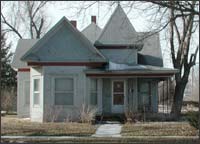 He and his wife lived in a house on Houck Street. Ron says that after he left Pawnee Rock, he went to work as a network consultant for IBM and eventually retired in Indianapolis, then moved to Hutchinson. He bought a "crack" house a couple of years ago and remodeled it, he beat back a case of leukemia, and he works part time at a leather store. And that's how I remember him -- more energy than you can shake a stick at. He makes it through Pawnee Rock now and then. A testimonial for Mrs. Wilhite: I'm not the only fan of retired teacher Mary Louise Wilhite. Leon Miller wrote from Dallas: "Mary Louise Hill, who later became Mary Louise Wilhite, was my 4th or 5th grade teacher. She was the ultimate educator and took great care in getting the most out of her students. I always considered her as one of my favorite teachers and enjoyed seeing her whenever I returned to Pawnee Rock on Memorial Day weekend. "She was one of my aunt's (Lucille Miller Jones) closest friends. I think they both taught together in the 1940s." About that fire photo: In a box of photos Dad passed along was a set of 8x10 prints of a house on fire. One of the shots is today's homepage photo. Other photos show firefighters climbing on the roof, neighbors carrying household goods across the street, and other fire equipment. I'll scan in the rest of the shots too and post them. 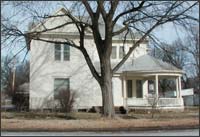 Judging by the clothing and vehicles, the fire seems to have occurred in the 1940s. Maybe you were there. If you know anything about the fire, please tell us about it. The house is still standing, of course, but the landscaping has changed. The tree in front of the porch has disappeared, but a photo made in 2005 shows that a new tree grew up to its west. Goodbye, snow: For several days, the last patch of ice held on in our yard. Yesterday morning, it was down to the dimensions of a possum long ago flattened by 18-wheelers. Yesterday afternoon, it melted away. Finally, spring has arrived -- officially, by my fiat -- at latitude 61 north, longitude 149 west. I know that spring came a long time ago to wherever you live; it might even be summer by now. And I'm not complaining about having snow on the ground for seven months. Still, until sweater weather arrives next September, I'm not going to miss the snow. A gift from Mrs. Wilhite[May 3] A couple of weeks ago, I got a note from Larry Mix, who sends us photos now and then. "Was at the hospital this morning to take care of my mother and her bed partner in the same room was an elderly lady. In the conversation just passing time she mentioned that she taught school in PR. You know me, I gave a plug for a great website I know of and the person that runs it from Alaska. Well, as with older folks out came the stories. The one she told was of a 3rd or 4th grader that had just been handed a paper with and 'F' on it. She said this young man was so excited about getting this 'F' that he stood up and waved it around as if he had gotten an award or something besides this 'F.' She also said that this same person always got 'A.'" 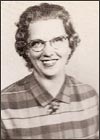 The teacher with the fine memory was Mary Louise Wilhite, my second-grade teacher at Pawnee Rock Grade School. The boy with the odd sense of success was yours truly. Yesterday I got a handwritten letter from Mrs. Wilhite -- a note from the teacher, 42 years later. She wrote that she had finally retired for good from teaching, having been at the head of the class as a full-timer and substitute for 50 years. Her husband, Woody, died five years ago, and their sons, John and Jack, are in the trucking business. John owns his own company in Larned, and Jack drives for FedEx out of Amarillo. As a kid, I always thought of the graceful Mrs. Wilhite as "our" teacher because she lived only a block and a half from our house. The Wilhites' former home stands at Centre and Bismark streets. It was awfully good to hear from Mrs. Wilhite. It's nice to be remembered, isn't it, and even better to be remembered kindly. Mrs. Wilhite is in St. Joseph's Hospital in Larned for a little while, rehabilitating from a broken hip. You can write to her at this address: Mary Louise Wilhite And write neatly! She's still your teacher. Pieces of Lena Unruh's life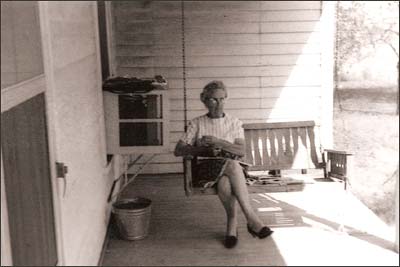
[May 2] On warm evenings, Lena Unruh sat on the porch. Dill weed grew at the edge of it, sweetening the air. Barn swallows flitted in and out of dried-mud nests under the porch's roof. By the time Lena sat down in the evening, the chickens would have already been shut in. If the heifers were at the barn, she would hear them low. Lena Schultz was born in November 1898 and married Otis Unruh after World War I, becoming his second wife. Their farmhouse northwest of Pawnee Rock had been built a generation earlier by her father-in-law. Lena and Otis produced three sons and a daughter, and eventually they had six grandchildren, of whom I am the third. The children did not have carefree childhoods; medical conditions and the Great Depression and occasionally harsh parenting saw to that. When the children grew up, they didn't move far from home. Otis died in the night during the fall of 1965 and was buried in the Mennonite cemetery, which Lena drove past on Wednesday afternoons on her way to stitch quilts with the Mennonite women at the Bergthal church. On Sundays when she didn't want to drive her white 1962 Impala, she rode with us to church and then out to eat at the Blue Goose in Larned or at Ralph Wallace's in Great Bend. The two-story house had pieces of dark furniture built by her father. In addition, in one corner of the parlor sat a pump organ, which Otis played often as a young man but not so much after his arthritis became a problem. After Otis' death, the gold-accented Zenith television became Lena's companion as much as the dog Shep was. The farm covered 160 acres. When it was new, there wasn't a tree. By the 1960s, the shelterbelts on the north side of the buildings were thick with cedars and honey locusts. The land grew milo and wheat, and part of it was in never-broken pasture through which the children walked when they attended the one-room school a couple of miles north. Lena's phone was on a party line. She liked to pick up the handset and listen after hearing the ring for another farm. She knew others did the same to her calls, so she and her cousins spoke low German among themselves. The phone was black and angular, and it sat on a square table near the parakeet's cage. Her number was 4458. On Sunday, Lena favored simple dresses of pink and green. During the week, she wore cotton dresses. If the day was cold, she wore Otis' old denim jacket, which hung on a wire hook behind his rocking chair inside the dining room next to the propane furnace. Coming back from tending to the chickens or cattle, she scraped her shoes on a steel disc half-buried where the concrete sidewalk passed under the elm at the yard's gate. Lena baked. She canned vegetables. She chipped chunks of ice to cool the water that she took to the wheat fields for Otis. She washed her dishes in laundry soap because it was less expensive, and she hung the weekly laundry on wire lines stretched across the yard this side of the outhouse. Until the 1960s, a wood-burning range dominated the kitchen even after the gas range was installed. She sprinkled her sliced tomatoes with a spoonful of sugar. When Lena Unruh sat on the porch swing, perhaps she talked to Jesus. Maybe, but I never heard her pray anywhere but church and at the table. Was she happy? Had life been a disappointment? Lena left the farm in the 1980s after her own health failed, and the farm was sold and the house destroyed. At the end, she was lost, and she died May 10, 1990. I wonder whether, as she sat tied in her wheelchair at the nursing home, Lena Unruh thought of the porch swing. Among all the pieces of her life, did she remember the dill weed in the evening air? The next generation[May 1] We start off the happiest month of the year -- graduation gowns, green fields, May flowers from April's rains -- with the happiest kind of news. 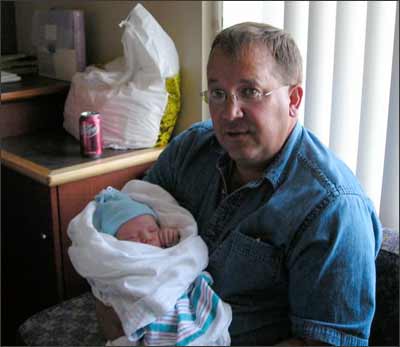 My classmate Richard Batchman, who grew up in Pawnee Rock and went to Otis-Bison after our high school was closed, has become a grandfather. "My first grandchild was born on Saturday morning 4/28/07," Richard wrote. "Bradyn Price Batchman is the son of Christopher and Danielle Batchman of Manhattan, Kansas. Chris is our oldest son and is a Army Reserve Recruiter for the northeast region of Kansas. Danielle is a communications specialist for AT&T. I just can't believe how fast the years are flying by." Congratulations to Christopher and Danielle, and to Richard and Debbie. Richard and Debbie live north of Pawnee Rock on the old George Adam Geil place along the Dry Walnut. Richard was one of the nicest fellows in our school . . . just the kind of guy who could spoil Bradyn through and through. |
Sell itAdvertise here to an audience that's already interested in Pawnee Rock: Or tell someone happy birthday. Advertise on PawneeRock.org. |
|
|

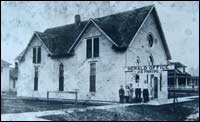
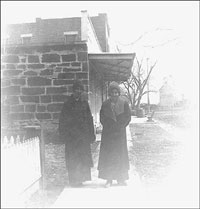
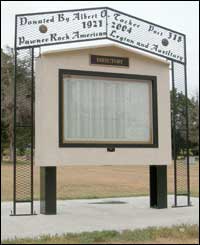 If you haven't been to the cemetery lately, you'll be pleasantly surprised by the American Legion's gift: a grave directory. It's in the center of the cemetery, where the ceremony will be.
If you haven't been to the cemetery lately, you'll be pleasantly surprised by the American Legion's gift: a grave directory. It's in the center of the cemetery, where the ceremony will be.
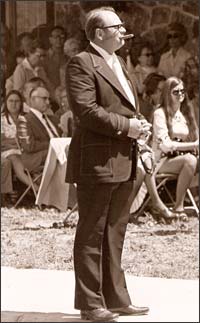 [May 19] Now and then you meet somebody who is perfect at being who he is. In the mid-1970s, one of those folks was Roger Grund.
[May 19] Now and then you meet somebody who is perfect at being who he is. In the mid-1970s, one of those folks was Roger Grund.